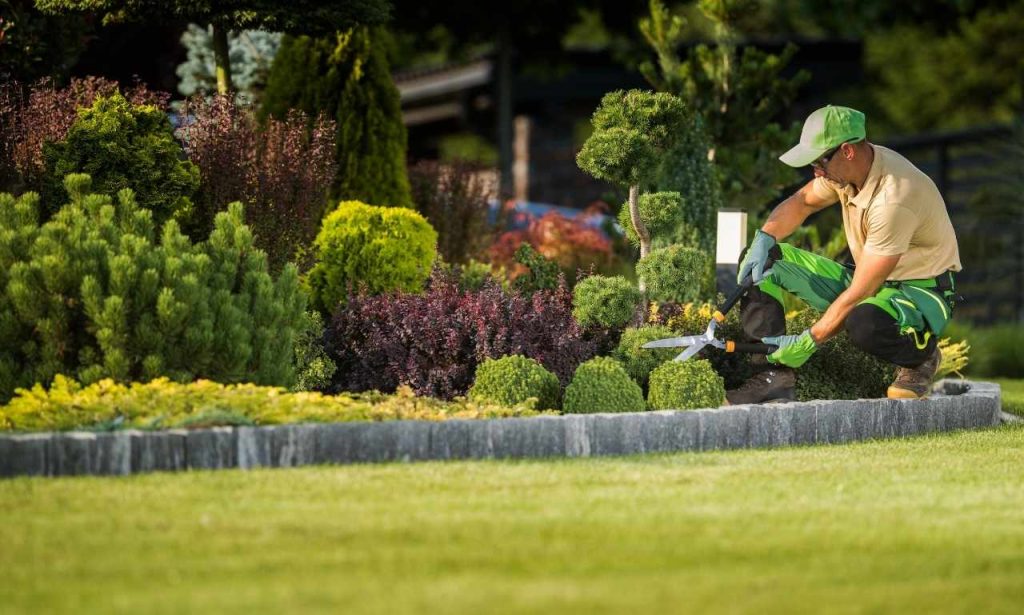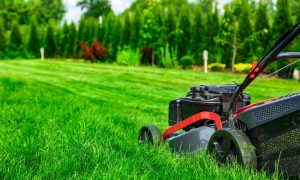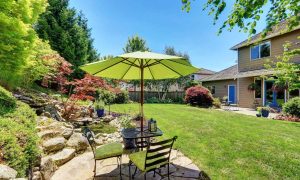Garden borders make all the difference in landscaping. They separate areas and add structure to outdoor spaces. Good borders turn ordinary gardens into eye-catching displays. They also help keep plants in place and stop grass from spreading. Many homeowners struggle with choosing the right border style. This article covers various border options to suit different tastes and needs. You’ll find budget-friendly ideas alongside more luxurious options. The right border can transform your entire yard’s appearance. Let’s explore the unique and inspiring landscaping border ideas to help beautify your outdoor space.
What is a Landscaping Border?

A landscaping border defines the edge between different garden areas. It creates clear boundaries between lawns and flower beds. Borders prevent soil erosion and keep mulch in place. They stop grass from invading garden beds and reduce maintenance time. Good borders add visual interest and enhance your garden design. They come in countless materials, shapes, and styles. Some borders are purely decorative, while others serve practical functions. The right border complements your home’s architecture and existing landscape. Borders can be subtle or bold statement pieces. They’re essential elements in creating organized, polished outdoor spaces.
Types of Landscaping Borders
Landscaping borders fall into three main categories. Each type offers unique benefits for different garden styles. Your choice depends on your personal taste and garden needs. Let’s examine these different border types.
Natural Borders
Natural borders blend seamlessly with the surrounding environment. They use materials found in nature, like rocks or plants. These borders create soft transitions between different garden areas. Many gardeners prefer them for their organic, effortless appearance. Plant-based borders like lavender hedges add fragrance and color. Stone borders weather beautifully and improve with age. Fallen logs and driftwood make striking borders in rustic gardens. Natural borders attract beneficial insects and wildlife to your garden. They typically require less processing and have a lower environmental impact. These borders work especially well in cottage or woodland garden styles. The irregular shapes create interest and movement in the landscape.
Man-made Borders
Man-made borders offer precision and clean lines. They’re crafted from materials like brick, concrete, or metal. These borders typically last longer than natural alternatives. They provide strong, defined edges that stay in place. Metal edging creates sleek, modern lines in contemporary gardens. Brick borders add classic charm that complements many architectural styles. Concrete curbing can be stamped or colored to match your design. Man-made borders resist shifting and maintain their shape over time. They often require professional installation for best results. These borders work well when you want neat, controlled garden lines. They’re excellent for creating raised beds with precise dimensions.
Creative Borders
Creative borders showcase your personality and imagination. They repurpose unexpected items into unique garden features. Old bottles, broken pottery, or salvaged materials find new life. These borders become conversation pieces in your garden. Wine bottle borders create colorful light effects when sunlight hits. Repurposed pallets make interesting wooden borders with minimal cost. Mosaic borders add artistic flair with broken tiles or dishes. Creative borders tell stories and hold memories. They reduce waste by giving materials a second purpose. Children enjoy helping with these fun, artistic projects. These borders make your garden truly one of a kind.
Amazing Landscaping Border Ideas
Looking for inspiration? Here are some excellent border options. Each offers unique benefits for different garden styles. Try one or combine several for added interest.
Bricks or stones flower bed edging
Brick edging brings timeless appeal to any garden. It withstands harsh weather and improves with age. Bricks can be arranged in countless patterns and designs. You can lay them flat, upright, or at angles. Red clay bricks warm up garden spaces with their rich color. Reclaimed bricks add character with their weathered appearance. My neighbor used antique street bricks from our town’s historic district. Her garden border tells a local history story now. Stone edging works similarly but with more natural variation. Both options require minimal maintenance once properly installed. They stay put during mowing and resist damage from garden tools.
Metal landscape edging
Metal edging delivers clean, contemporary lines to modern gardens. It creates crisp divisions between lawn and garden beds. Steel edging develops an attractive rust patina over time. Aluminum stays silver and never rusts or corrodes. Corten steel offers that perfect rusty look without structural weakness. Metal borders allow for curved designs or straight lines. They’re thin enough to disappear into the landscape. I installed metal edging five years ago in my front yard. It still looks brand new despite snow plows and weed whackers. Professional installation works best for long sections. Metal borders last decades with virtually no maintenance needed.
Concrete curbing for durability
Concrete curbing offers unmatched durability in garden borders. It’s poured in continuous sections for a seamless appearance. Many color options match your home or existing hardscape. Stamping creates patterns resembling brick or stone. Concrete borders prevent grass roots from invading beds. They stay perfectly in place through freezing and thawing cycles. My sister’s concrete curbing has survived fifteen Minnesota winters. It still looks exactly like the day it was installed. Professional installation ensures proper drainage and setting. Once installed, these borders need almost no maintenance. They create permanent garden bed definitions.
Wooden log edging for a rustic look

Wooden log edging brings natural charm to casual gardens. Cut logs create distinctive borders with organic appeal. They work perfectly in woodland settings or cottage gardens. Cedar and locust logs resist rot naturally. Other woods need treatment for longer life. Logs can be placed vertically or horizontally for different effects. They break down slowly, enriching soil as they age. My friend collected fallen oak branches after a storm. She created a beautiful border that cost nothing but time. Wooden borders attract beneficial insects and small wildlife. They blend perfectly with natural planting styles.
Recycled glass bottle border
Glass bottle borders add unexpected color and whimsy. Buried upside-down, bottles create colorful garden edges. Sunlight creates beautiful effects through colored glass. Wine and beer bottles work perfectly for this purpose. Bottles can follow straight lines or create curved patterns. They survive for decades in the soil without degrading. My grandmother’s bottle border dates back to the 1970s. The cobalt blue medicine bottles still glow brilliantly in sunlight. This border style makes great use of items usually discarded. Children find these magical borders especially appealing.
Flagstone for a natural look
Flagstone creates elegant, natural-looking borders with timeless appeal. The irregular shapes add organic movement to garden edges. Flat stones can be partially buried for a seamless look. They provide stable edges that resist shifting over time. Natural stone colors complement plants beautifully. Flagstones work in both formal and casual garden designs. They create perfect stepping access into garden beds. My cousin collected stones from a nearby riverbed. His garden border tells the geological story of our region. Flagstones improve with age as mosses grow between cracks. They require minimal maintenance beyond occasional repositioning.
Factors to Consider When Choosing a Landscaping Border
Selecting the right border involves several important considerations. Think about these factors before making your final choice. Your satisfaction depends on finding the perfect match.
Cost
Budget considerations affect border material choices significantly. Natural materials gathered locally often cost very little. Manufactured borders vary widely in price points. Installation costs sometimes exceed material expenses. DIY-friendly options save on labor costs. Consider long-term value rather than just initial price. Expensive borders might last decades longer than cheap alternatives. My budget-friendly river rock border cost nothing but transportation. Compare total costs including preparation and installation. Some materials require special tools or skills. Factor in replacement costs for less durable options.
Maintenance requirements
Different border materials demand varying levels of maintenance. Metal and concrete borders need almost no upkeep. Wooden borders require occasional replacement as they decompose. Plant borders need regular trimming and possible replanting. Stone borders may need occasional repositioning after frost heaving. Consider your available time for garden maintenance. Low-maintenance borders save countless hours over years. My busy schedule makes me appreciate my maintenance-free metal edging. Some borders require seasonal attention or protection. Assess your willingness to perform regular upkeep tasks.
Compatibility with existing landscaping design
Your border should complement your overall garden style. Traditional homes pair naturally with brick or formal hedges, while contemporary designs work well with clean metal lines. Consider your home’s architecture and existing hardscape. Colors should coordinate with your home and other garden features. Border height should transition appropriately between spaces. The border pattern should reflect your garden’s level of formality. My Tudor-style home looks perfect with curved brick borders. The border material should make sense with your climate. Desert gardens suit borders different from those of woodland settings.
Functionality
Different borders serve different practical purposes. Some prevent grass invasion more effectively than others. Raised borders keep mulch from washing away. Deep barriers block underground rhizomes and roots. Consider whether pets or children need deterrence. Some borders withstand foot traffic better than others. Evaluate whether edging needs to support garden tools. My metal edging doubles as a mowing strip. Assess whether the border should be temporary or permanent. Some gardens benefit from borders that can be moved seasonally.
Maintenance Tips for Landscaping Borders

Proper maintenance extends the life of your garden borders. Follow these simple tips for best results. Regular attention prevents bigger problems later.
Clean regularly and remove debris
Remove fallen leaves and debris from borders regularly. This prevents organic matter from decomposing against materials. Clean borders are less likely to grow weeds, and cleaning prevents staining on lighter-colored materials. I brush my brick border with a stiff broom monthly. This simple habit keeps it looking fresh year-round. Remove soil that splashes onto borders during heavy rain. Cleaning prevents moss and algae from becoming established. Regular maintenance makes borders more attractive and functional.
Check for damage or wear
Inspect borders seasonally for signs of deterioration. Look for cracked bricks, shifted stones, or rotting wood. Winter frost often causes materials to heave or crack. Animal activity might undermine or disturb border materials. Catching problems early prevents more extensive damage. My spring inspection revealed two frost-heaved bricks last year. Fixing small issues prevents them from spreading further. Check that borders still perform their intended function. Ensure that edges remain defined and separate.
Promptly replace broken materials
Replace damaged border sections as soon as you notice problems. Matching materials becomes harder the longer you wait. Broken borders lose functionality and appearance quality. Keep spare materials on hand for quick repairs. Single broken pieces can compromise entire border sections. I keep extra bricks stored in my garage for replacements. Prompt repairs prevent further deterioration of adjacent sections. This maintains both function and visual appeal.
Apply sealant to wooden borders
Treat wooden borders with preservative or sealant yearly. This extends their life significantly in wet conditions. Choose eco-friendly products that are safe for garden use. Sealants prevent premature rotting and insect damage. Many treatments enhance wood’s natural beauty and color. My cedar log border gets treated every spring. This simple step has doubled its expected lifespan. Apply the sealant during dry weather for best absorption. Proper treatment makes wooden borders much more cost-effective.
Add fresh mulch or rock
Refresh organic materials that work alongside hard borders. Replenish mulch that has decomposed or washed away. Add new stones where existing ones have sunk into the soil. This refreshes the border’s appearance and function. Clean, fresh materials make older borders look renewed. I add new river rocks to my border every other year. The border looks freshly installed after this simple update. Fresh materials restore proper height and coverage. They complement and highlight your border’s best features.
Trim or prune plants
Maintain living borders through regular trimming and care. Prune hedges to maintain clean, defined lines. Remove dead sections of plant-based borders promptly. Control plant borders before they become overgrown. Trimming maintains the intended height and width. My lavender border needs trimming three times yearly. Regular maintenance prevents woody growth and promotes flowering. Keep plants healthy with appropriate water and fertilizer. Healthy plant borders grow more densely and attractively.
Conclusion
The right landscaping border transforms your entire garden. It adds structure, reduces maintenance, and enhances beauty. Consider your garden style and practical needs when choosing. Factor in budget, maintenance requirements, and compatibility with existing features. Regular upkeep ensures your borders remain attractive for years. Whether you prefer natural materials or manufactured products, options abound. Your perfect border awaits among these inspiring ideas. Take time to select something that truly reflects your style. Your garden’s finished appearance will reward your careful consideration.
Also Read: How to Design a Stylish Minimalist Home
FAQs
Prices range from nearly free (gathered stones) to $25+ per linear foot for professional concrete curbing.
Metal and concrete borders typically require minimal upkeep once properly installed.
Reclaimed materials, locally sourced stones, and plant-based borders offer environmentally friendly solutions.
Cedar, redwood, and treated woods can last 7-10 years with proper sealing and maintenance.
Deep metal or plastic edging that extends 5-6 inches underground works best as a grass barrier.



